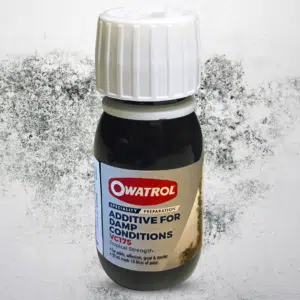The cold, wet winter months are hopefully now on their way out and we can look forward to lighter evenings, warmer weekends and a little more sun!
At this time of year we often begin to think about spring cleaning and even the dreaded redecoration! Have you found unsightly patches of mould have popped up on walls or ceilings over the Winter months? Then this guide could be very handy for you!
If you have mould growth on painted surfaces like walls and ceilings the thing NOT to do is just to paint over the top to hide it! This will essentially be a waste of time as the mould will continue to grow and will soon show through your new paintwork. This will result in a waste of time and money.
The best course of action is to treat the mould to kill it and this process is simpler than you may think.
Use a mould remover
Before you begin we recommend you remove and treat the mould that has appeared. There are many different types of mould remover products on the market so we recommend doing a little research to see which is best for you and the surface you are treating.
After following the instructions and the surface is now fully dry, you can then treat and prevent mould from returning with VC175.
Preventing mould growth with VC175 Mould Killer

VC175 Mould Killer is a powerful and long-lasting mould killer. It provides long-term protection against unsightly and smelly mould, as well as algae.
It can be added to a wide variety of products; such as paint, timber stains, textured coatings, grout, mortar and adhesives. To use VC175, simply add to your paint in the quantities listed below and apply the paint as directed.
- Water based and solvent based paints and stains: Add 5ml of Mould Killer VC175 per litre of paint or stain and stir thoroughly.
- Mortar, grout, textured coatings, fillers, adhesives: Add 5ml of Mould Killer VC175 to each kg of ready to use product.
We hope you found this guide on how to treat and prevent mould interesting.
If you have any other advice or top tips, please feel free to leave them in the comments below. We love hearing from you!
You can also follow us on Twitter, Facebook, Instagram or Pinterest at @OwatrolUK or find us under the hashtag #OwatrolUK







Would like to know how to get rid of mould on a timber ceiling in a kitchen. The timber is varnished. Thanking you.
Hi Angela,
I have passed your question onto our technical team and will let you know their response asap.
Many thanks,
The Owatrol Team
Hi Angela,
Our technical team have the following advice for solving your mould growth problem. First strip the varnish using DSP 800 so that you have access to the mould growth. Then you will need to clean this with a 50/50 mix of hot water and bleach. If you are then going to varnish the timber again, then you should add VC175 to the varnish and this will prevent new mould growth.
Hope this is of help to you, many thanks,
The Owatrol Team